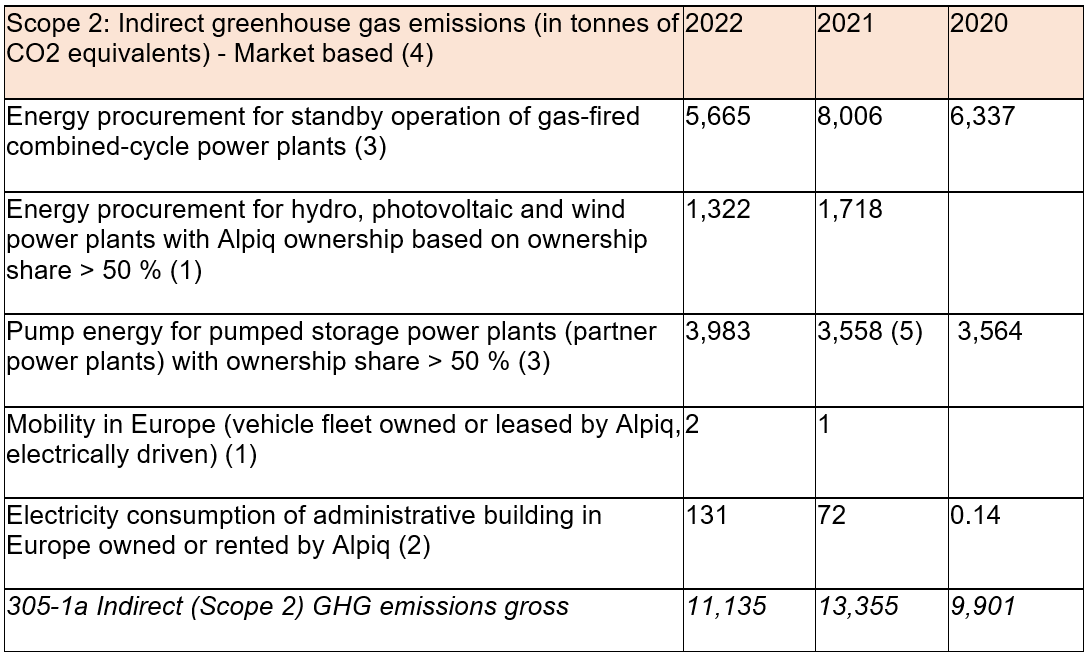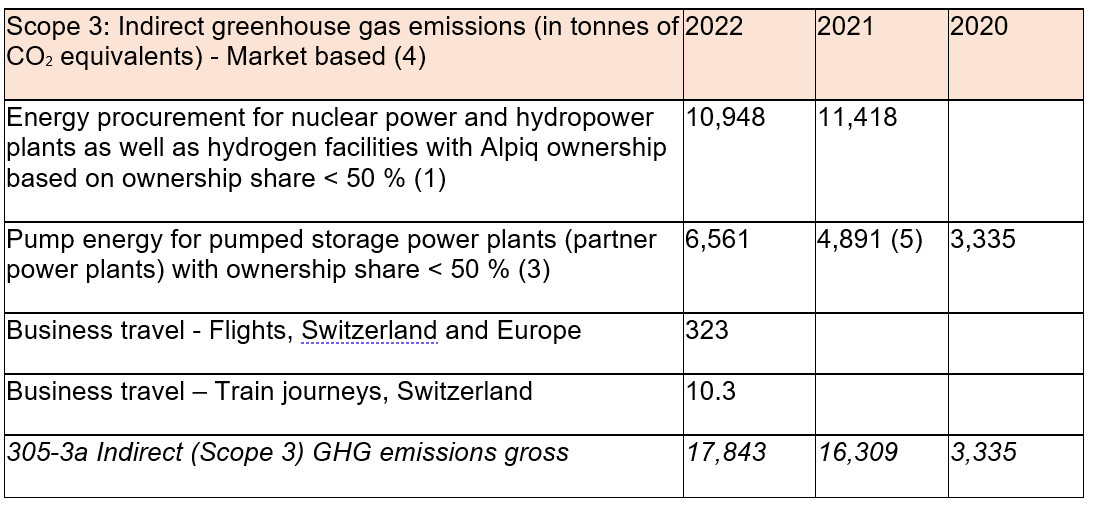Emissions
GRI 305-1: Direct greenhouse gas emissions (GHG emissions) (Scope 1)
Scope 1 covers direct emissions from fossil fuels. Regarding Alpiq’s activities, electricity production from gas-fired combined-cycle power plants is the main source of emissions. Scope 1 emissions of gas power plants (CCGT) are aligned with the national registry’s declarations of each country. Emissions resulting from the consumption of buildings and vehicles owned by the company are included too.
GRI 305-2: Energy indirect (Scope 2) GHG emissions
Scope 2 covers indirect emissions from electricity consumption and district heating of majority shareholdings power plants, leased buildings and all-electric vehicles. This year, the declaration of Scope 2 emissions considers the effective “market based” energy mix of the consumed energy, as compared to the standard “location based” energy mix.
GRI 305-3: Other indirect (Scope 3) GHG emissions
Scope 3 currently covers only indirect emissions from energy procurement from minority interests, leased buildings as well as emissions relative to professional travel (flights and train travel). We are elaborating comprehensive report on Scope 3 emissions for the year 2023, which will also include the trading business.
All types of power plants are included since 2021. Emissions from professional travel linked with all our professional activities in Switzerland and Europe have been included in Scope 3. The calculation process and GHG declaration have been conducted in accordance with the GHG protocol and “GRI 305” standard and checked externally by a third-party expert.



(1) The value for the year 2020 was not determined.
(2) In 2020, only the values for administrative buildings in Switzerland were surveyed.
(3) The calculations for 2020 are based on the respective country-specific supplier mix.
(4) Market based - The calculations for 2022 are based on the effective energy mix when origination is available (certificates or chosen specific energy mix).
(5) Recalculation of 2021 values. Certificates of origin only covers the pumping losses and not the full energy procurement.
(6) Recalculation of 2021 values. Double count of the scope 1 emissions relative to CCGT diesel emergency power generator, which are included in national registry totals.
With 98.6% of the total share of GHG emissions declared in 2022, electricity production from gas-fired combined-cycle power plants is the main source of emissions. 2022 emissions show a significant increase, due directly to the significant increase in CCGT production. The restart of production of Plana del Vent CCGT, Spain and the high demand during this particular year explains this increase in terms of total value. However, in terms of intensity, the CCGT GHG emissions are still decreasing (see “GRI 305-4”).
Scope 2 and Scope 3 emissions remains relatively constant and are mainly caused by energy procurement of power plants, representing approximately 1.4% of the total emissions. Mobility and offices emissions remains fairly low, even with the addition of the business travel emissions. The 2022 emissions relative to all business flights and train journeys are compensated through third-party project funding.
GRI 305-4: GHG emissions intensity
The year 2022 has been a extraordinary one on European level, with lower production capacities and a very high energy demand. Contrary to renewable energy technologies, which provide little flexibility in terms of production as they depend on natural resources, as well as nuclear power plants, gas power plant (CCGT) have contributed strongly to the security of supply in 2022 with a high production volume, resulting in a proportionate increase in total emissions. In terms of intensity, the CCGT emissions are therefore decreasing gradually, with successive improvements and refurbishments of the different power plants and due to their higher load factors.

(6) Calculation including CCGT scope 1 and 2 emissions (direct and indirect energy procurement of production asset) and net electricity production as reported in Alpiq’s annual report.
On an Alpiq Group level, our renewable and nuclear assets include significantly lower greenhouse gas intensity. The higher share of CCGT production induces a 24 g CO2e / KWh raise compared to 2021. The global intensity is therefore mainly driven by the CCGT emissions.

(7) Calculation including full scope 1 and 2 emissions (direct and indirect energy procurement, production asset, offices and mobility), partial scope 3 emissions (direct and indirect energy procurement of minority interests, professional flights and Swiss train journeys) and net electricity production as reported in Alpiq’s annual report.
GRI 305-7: Nitrogen oxides
The nitrogen oxide emissions (NOx) are measured online in all gas-fired combined-cycle power plants. Emissions primarily depend on the production of electricity and steam, which can fluctuate depending on market conditions or customer requirements. Alpiq is constantly modernising its power plants. In doing so, the company makes use of the best available technology, including dry-low NOx facilities in order to reduce NOx emissions and thus protect the environment. Alpiq meets all European and local environmental requirements for gas-fired combined-cycle power plants. Total NOx emissions increased in 2022, due to the increase of our CCGT assets total production of 54 % compared to 2021. In terms of intensity, 2022 shows a significant decrease due to higher load factors, which increase NOx treatment efficiency, and the restart of production of refurbished Plana del Vent CCGT.
Those emissions are aligned with the national registry’s declarations of each country.

Nuclear: radiation exposure
At the nuclear power plants in which Alpiq holds shares, there were no radiation doses to environment above the legal limits in 2021 and 2022. Further information on radiation doses can be found in the ENSI Radiation Protection Report 2021 (ENSI-AN-11280) and 2022, to be published mid-2023.